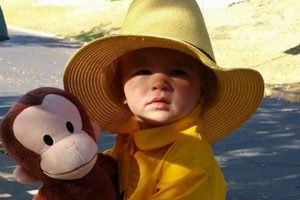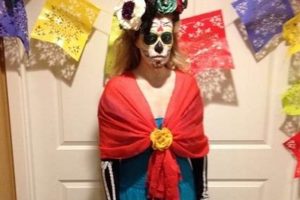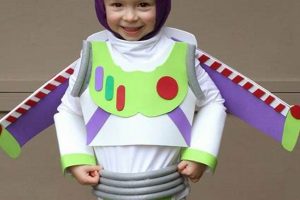The act of creating a personalized pharaonic garment and associated accessories allows individuals to embody the iconic image of the Egyptian queen through self-made apparel. This process often involves repurposing existing clothing items, crafting jewelry from readily available materials, and applying creative makeup techniques to achieve the desired aesthetic.
Engaging in this type of costuming fosters creativity, resourcefulness, and historical appreciation. The practice allows for a unique interpretation of the historical figure, promoting individual expression while remaining within the established visual framework. The completed results can serve as celebratory attire for various events or as a statement of personal artistry.
The following sections will outline specific methods for constructing various components, detailing material choices, and offering guidance on makeup application, providing a complete approach to crafting an authentic-looking interpretation of the Egyptian queen.
Essential Construction and Styling Advice
This section provides critical guidance to ensure a successful creation, addressing material selection, construction techniques, and stylistic considerations to achieve a historically inspired and visually compelling result.
Tip 1: Fabric Selection is Paramount. Choose fabrics such as linen-like materials or flowing silks in colors of white, gold, or blue to evoke the appropriate aesthetic. Avoid modern synthetics that detract from the historical authenticity.
Tip 2: Prioritize Accurate Silhouette. The garment should typically feature a long, straight silhouette, often embellished with pleats or folds. Avoid excessively modern tailoring that deviates from the traditional Egyptian style.
Tip 3: Adornments Enhance the Look. Utilize metallic paints, beads, and faux gemstones to embellish the collar, cuffs, and belt. Precisely apply these elements to ensure symmetrical and aesthetically pleasing designs.
Tip 4: The Headdress is Integral. Construct a Nemes headdress using stiffened fabric or cardboard. Accurately replicate the stripes and incorporate a uraeus (cobra) and vulture emblem at the front for a symbolic representation of royalty.
Tip 5: Makeup Requires Precision. Apply heavy eyeliner using black kohl or liquid liner, extending the lines beyond the natural corners of the eyes to create a dramatic, elongated effect. Contour the face subtly for added definition.
Tip 6: Consider Jewelry Authenticity. Create or acquire jewelry pieces that mimic ancient Egyptian designs, focusing on gold tones, lapis lazuli, turquoise, and carnelian. Incorporate symbols like the ankh, scarab, and lotus flower.
Tip 7: Accessorize with a Scepter. A scepter or staff, often adorned with gold and symbolic elements, enhances the regal appearance. Ensure the scepter is appropriately sized and proportioned to the overall scale of the creation.
By following these essential tips, one can achieve a visually striking and historically influenced creation that effectively embodies the iconic image of the Egyptian queen. Attention to detail and accurate representation are paramount for success.
The following section will delve into specific tutorials and project ideas, offering step-by-step instructions for constructing various elements of the garment and accessories.
1. Fabric selection
Fabric selection exerts a significant influence on the overall aesthetic and perceived authenticity of a homemade pharaonic garment. The choice of material directly impacts the drape, texture, and color palette of the final creation, contributing either positively or negatively to its visual impact. Inappropriate material can detract from the intended historical representation, while careful selection enhances the perceived accuracy and attention to detail. For instance, a modern, brightly colored synthetic fabric would undermine the historical context of a garment intended to evoke ancient Egypt, whereas a natural fiber such as linen, or a linen-like fabric in off-white or cream, would contribute to a more credible aesthetic. Similarly, silk, with its fluid drape and subtle sheen, can effectively simulate the luxury associated with royalty.
The practicality of fabric selection extends beyond mere aesthetics. The weight and breathability of the chosen material affect the wearer’s comfort, particularly during extended periods of wear or in warmer climates. A heavy, non-breathable fabric can lead to discomfort and overheating, rendering the ensemble impractical for events such as costume parties or theatrical performances. Conversely, a lightweight, breathable fabric ensures comfort and allows for ease of movement, making the homemade pharaonic garment a viable and enjoyable option. Consider cotton blends as a middle-ground, offering affordability, breathability, and a degree of historical plausibility. Careful consideration of these practical aspects improves the wearability and overall success of the creative undertaking.
Ultimately, fabric selection is a critical component in realizing a visually convincing and practically wearable pharaonic-inspired creation. By prioritizing materials that align with the historical context, aesthetic goals, and practical considerations, individuals can significantly enhance the quality and authenticity of their homemade projects. Neglecting this element can compromise the final result, diminishing the overall impact and undermining the efforts invested in other aspects of the project. Therefore, a thoughtful and informed approach to fabric selection constitutes an essential step in achieving a successful outcome.
2. Accurate silhouette
Maintaining an accurate silhouette is paramount when undertaking a homemade pharaonic garment. It directly affects the overall impression and recognizability of the depiction, establishing a crucial connection to the historical figure. The silhouette serves as the foundational element upon which further embellishments and details are built. Deviations from established historical outlines diminish the visual impact and potentially compromise the intended representation.
- Garment Shape and Flow
The fundamental shape of the garment significantly influences its authenticity. Typically, pharaonic attire features a relatively straight, columnar silhouette, emphasizing vertical lines. Modern alterations that introduce excessive shaping or form-fitting elements detract from the desired historical aesthetic. Example: a long, loose-fitting linen dress is preferable to a tailored, body-hugging design. The implications of inaccurate shaping can range from subtle misinterpretations to outright visual incongruity.
- Sleeve Design Considerations
Sleeve design presents another critical facet of silhouette accuracy. Sleeveless or minimally sleeved garments are general
ly consistent with historical depictions. The addition of voluminous or overly structured sleeves contradicts the characteristic simplicity and fluidity of pharaonic clothing. Example: avoiding puffed or bell-shaped sleeves, opting instead for straight, unadorned arm openings. The decision regarding sleeves impacts the overall balance and visual harmony of the silhouette. - Belt and Waist Placement
The placement and design of the belt contribute significantly to defining the waist and influencing the overall silhouette. A belt placed high on the waist, or directly below the bust, can create a visually elongated effect. Conversely, a belt placed low on the hips can distort the perceived proportions. Example: positioning a wide, embellished belt at the natural waistline to emphasize the columnar shape. Careful belt placement is crucial for achieving a balanced and historically inspired silhouette.
- Drape and Fabric Weight Impact
The drape of the chosen fabric plays a vital role in defining the silhouette. Stiff or heavy fabrics can create a boxy or unflattering shape, while lightweight, flowing fabrics enhance the garment’s fluidity and grace. Example: selecting linen or silk to achieve a naturally draping effect. The interplay between fabric weight and design directly influences the silhouette’s overall appeal and historical accuracy.
The preceding facets highlight the critical role of accurate silhouette in crafting a credible pharaonic garment. Paying meticulous attention to garment shape, sleeve design, belt placement, and fabric drape are essential for achieving a visually convincing representation. These elements collectively contribute to the overall success of the endeavor, ensuring a recognizable and historically informed depiction of the Egyptian queen.
3. Adornment detail
Adornment detail constitutes a critical component within the sphere of constructing a personalized pharaonic attire, directly influencing the perceived authenticity and visual impact of the final product. The meticulous selection and application of embellishments, such as metallic paints, beads, and faux gemstones, significantly elevate the overall aesthetic, transforming a basic garment into a recognizable representation of the Egyptian queen. Without careful attention to these details, the resulting creation risks appearing generic or lacking the requisite regal bearing. For example, a plain white dress, even if correctly shaped, will not evoke the intended image unless it is complemented by an elaborate collar adorned with gold paint and strategically placed faux lapis lazuli beads. The cause-and-effect relationship is clear: insufficient adornment diminishes the overall impact, while thoughtful and detailed embellishments enhance the perceived quality and authenticity.
The practical application of this understanding manifests in several ways. Individuals engaged in crafting these costumes must dedicate time to researching authentic Egyptian jewelry designs and motifs. This research informs the creation or acquisition of appropriate adornments, ensuring they align with the historical context. Consider the Nemes headdress: its visual impact is amplified by the inclusion of a meticulously crafted uraeus (cobra) and vulture emblem, often fabricated from painted cardboard or sculpted polymer clay. Similarly, the creation of a wide belt adorned with geometric patterns rendered in metallic paint or carefully arranged beads contributes substantially to the costume’s visual richness. The ability to accurately replicate or interpret these adornments is key to elevating the project from a simple garment to a believable depiction of a royal figure.
In conclusion, the meticulous execution of adornment detail is indispensable for realizing a visually compelling and recognizable homemade pharaonic garment. While challenges may arise in sourcing appropriate materials or mastering specific crafting techniques, the investment in time and effort is ultimately rewarded by the enhanced authenticity and overall impact of the final creation. This element effectively bridges the gap between a generic garment and a credible portrayal of the Egyptian queen, underscoring its significance within the broader theme of creative expression through historical costuming.
4. Headdress construction
The construction of a headdress represents a pivotal stage in realizing a homemade pharaonic ensemble. The headdress, particularly the Nemes, functions as an immediate indicator of royal status and is integral to conveying the image of the Egyptian queen. Its presence or absence dramatically alters the perceived authenticity and completeness of the creation. An improperly constructed headdress can detract from the overall effect, regardless of the quality of other costume elements. Consider a scenario where a garment accurately replicates the silhouette and adornments, but lacks a suitable headdress; the result is an incomplete representation, failing to fully embody the intended image. Conversely, a well-crafted headdress can significantly enhance the visual impact of an otherwise simple garment.
Specific construction techniques and material choices directly impact the headdress’s visual fidelity. Stiffened fabric, such as buckram or canvas, is frequently employed to provide structure and maintain the characteristic shape. Accurately replicating the distinctive stripes of the Nemes requires meticulous planning and execution, often involving the use of fabric paint or carefully applied strips of contrasting material. Furthermore, the inclusion of the uraeus (cobra) and vulture emblems, symbolic representations of Lower and Upper Egypt respectively, is crucial for conveying royal authority. These emblems, typically crafted from sculpted clay or durable fabric, are affixed to the front of the headdress, serving as prominent visual indicators of the wearer’s status. The omission or inaccurate representation of these elements undermines the historical accuracy and symbolic significance of the headdress.
In summary, the construction of a headdress is not merely an ancillary step but rather a central component in crafting a persuasive pharaonic ensemble. While challenges may arise in achieving the correct shape, replicating the iconic stripes, and accurately portraying the symbolic emblems, the effort invested in this element significantly elevates the overall authenticity and visual impact. A meticulously crafted headdress serves as an immediate and compelling indicator of royalty, solidifying the representation of the Egyptian queen and transforming a simple garment into a recognizable historical portrayal.
5. Makeup application
Makeup application constitutes a crucial aspect in the successful execution of a homemade pharaonic representation. The strategic use of cosmetics serves to enhance facial features, emulate the iconic aesthetic associated with the Egyptian queen, and solidify the overall visual impact of the portrayal. A poorly executed makeup design can undermine the authenticity of the costume, while a skillfully applied design elevates the ensemble, transforming a simple garment into a recognizable and compelling representation.
- Eyeliner Te
chnique and ImpactThe application of heavy eyeliner is perhaps the most recognizable element of the Egyptian makeup style. Black kohl or liquid liner is applied liberally to both the upper and lower eyelids, extending outwards beyond the natural corners of the eyes to create a dramatic, elongated effect. This technique, historically achieved with kohl, serves to emphasize the eyes and create a visually striking appearance consistent with depictions of ancient Egyptian royalty. The absence of this characteristic eyeliner significantly diminishes the perceived authenticity of the makeup design.
- Eyeshadow Considerations and Palette
Eyeshadow plays a supporting role in enhancing the overall eye makeup design. Earthy tones, such as browns, golds, and greens, are frequently employed to complement the black eyeliner and create depth and dimension. The strategic placement of these colors can further emphasize the elongated shape of the eyes and contribute to a regal aesthetic. An inappropriate color palette, such as the use of bright or neon shades, detracts from the historical accuracy of the makeup.
- Contouring and Facial Definition
Subtle contouring techniques can be employed to enhance facial definition and create a more sculpted appearance. Softly defining the cheekbones and jawline with a matte bronzer or contour powder adds dimension and contributes to a more polished look. Overly harsh or dramatic contouring techniques, however, can appear unnatural and detract from the intended aesthetic. The goal is to subtly enhance the existing facial structure without creating a jarring or artificial appearance.
- Lip Color and Historical Context
Lip color plays a relatively minor role in the overall Egyptian makeup design, with a focus on subtle, natural tones. Historically, lipsticks were created using natural pigments derived from plants and minerals, resulting in muted shades of red, brown, and ochre. The modern equivalent involves the application of a matte lipstick in a similar shade or the use of a tinted lip balm to provide a subtle hint of color. The use of overly bright or glossy lip colors is generally avoided, as it detracts from the historical accuracy of the makeup design.
These facets of makeup application, when carefully considered and skillfully executed, contribute significantly to the success of a homemade pharaonic ensemble. By prioritizing accuracy in eyeliner technique, eyeshadow selection, contouring application, and lip color choices, individuals can create a makeup design that enhances the overall authenticity and visual impact of the costume, transforming a simple garment into a compelling representation of the Egyptian queen.
6. Jewelry authenticity
Jewelry authenticity significantly impacts the overall effectiveness of a homemade pharaonic costume. The selection and design of jewelry, when accurately reflective of ancient Egyptian styles, contribute substantially to the perceived historical accuracy and visual appeal. In contrast, modern or anachronistic jewelry detracts from the intended aesthetic, diminishing the impact of even well-crafted garments and makeup. For example, incorporating plastic beaded necklaces or contemporary gemstone settings contradicts the characteristic designs and materials prevalent during Cleopatra’s era, undermining the desired historical representation.
The creation or acquisition of jewelry pieces that mimic ancient Egyptian designs enhances the costume’s authenticity. This often involves focusing on materials such as gold tones, lapis lazuli, turquoise, carnelian, and faience. Furthermore, the incorporation of symbolic motifs like the ankh, scarab, lotus flower, and Eye of Horus provides recognizable visual cues that reinforce the historical context. Replicating these elements, even with inexpensive materials, contributes significantly to the costume’s overall credibility. Consider a simple collar constructed from painted cardboard, embellished with faux lapis lazuli and gold paint, emulating the broad collars commonly depicted in Egyptian art; this element adds considerable value to the visual narrative.
In conclusion, prioritizing jewelry authenticity constitutes a crucial aspect of crafting a persuasive pharaonic ensemble. While challenges may arise in sourcing accurate replicas or mastering jewelry-making techniques, the effort invested in this area directly translates to an enhanced visual impact and a more compelling representation of the Egyptian queen. By focusing on historically appropriate materials, designs, and symbolic motifs, individuals can significantly elevate the quality and believability of their homemade creations, reinforcing the connection between costume and historical context.
7. Regal accessories
The incorporation of appropriate regal accessories elevates a homemade pharaonic ensemble from a simple costume to a recognizable representation of royal authority. These accessories, carefully selected and crafted, contribute significantly to the overall visual impact and perceived authenticity of the depiction.
- Scepter or Staff Symbolism
A scepter or staff serves as a potent symbol of power and authority within the context of a pharaonic portrayal. The design and material composition of the scepter contribute to its effectiveness; typically, these implements are adorned with gold or metallic finishes and may incorporate symbolic elements such as the ankh or lotus flower. An appropriately sized and proportioned scepter enhances the regal bearing of the individual and reinforces the visual message of authority. For example, a staff crafted from gilded wood, topped with a stylized lotus blossom, conveys a sense of power and sophistication appropriate for a queen.
- Uraeus and Vulture Headdress Emblems
While the headdress itself is a primary component of the costume, the presence and accurate rendering of the uraeus (cobra) and vulture emblems are critical for conveying royal status. These emblems, traditionally representing Lower and Upper Egypt respectively, are prominently displayed on the front of the headdress. Their absence or inaccurate depiction detracts from the intended message of power and dominion. Consider a Nemes headdress fabricated from accurately striped fabric but lacking the uraeus and vulture; it presents an incomplete and less convincing representation of royal authority.
- Broad Collar (Wesekh) Design and Materials
The broad collar, or Wesekh, is a distinctive piece of Egyptian jewelry that significantly enhances the regal appearance. Typically crafted from multiple strands of beads or precious metals, the Wesekh drapes across the chest and shoulders, adding visual weight and richness to the costume. Accurately replicating the design and materials of the Wesekh contributes substantially to the overall authenticity of the portrayal. An example would be a collar constructed from layered strands of faux lapis lazuli, carnelian, and gold beads, meticulously arranged to mimic the intricate designs found in ancient Egyptian art.
- Ceremonial Fan Function and Style
A ceremonial fan, often made from feathers or woven materials and adorned with precious metals, adds an element of elegance and sophistication to the ensemble. While not strictly essential, a well-crafted fan can enhance the overall impress
ion of royalty and elevate the visual narrative. The fan’s design should be consistent with the other elements of the costume, incorporating similar materials and motifs. A peacock feather fan, trimmed with gold leaf, provides a striking and historically inspired accessory.
These regal accessories, when thoughtfully selected and integrated into a homemade pharaonic garment, transform a simple costume into a compelling representation of royal authority. Each accessory contributes to the overall visual narrative, reinforcing the connection between the individual and the iconic image of the Egyptian queen. These details collectively enhance the costume’s authenticity and elevate the overall impact of the creative endeavor.
Frequently Asked Questions
This section addresses common inquiries and concerns regarding the creation of personalized pharaonic attire. The information presented aims to provide clarity and guidance for individuals undertaking this creative endeavor.
Question 1: What constitutes a historically accurate fabric choice for a “diy cleopatra costume?”
Linen or linen-like materials, silk, or lightweight cotton blends are generally considered appropriate. Avoid synthetic fabrics with a modern sheen or texture, as these detract from the historical aesthetic. Colors should primarily consist of white, off-white, cream, gold, or muted blues and greens.
Question 2: How can a convincing Nemes headdress be constructed at home?
The Nemes headdress can be fashioned from stiffened fabric or cardboard, carefully shaped and painted to replicate the distinctive stripes. The uraeus (cobra) and vulture emblems, symbols of royalty, should be accurately depicted and affixed to the front. Securing the headdress comfortably and securely is essential.
Question 3: What is the correct technique for applying Egyptian-style eye makeup?
Heavy black eyeliner is a defining feature. Apply kohl or liquid liner liberally to both the upper and lower eyelids, extending the lines beyond the natural corners of the eyes to create a dramatic, elongated effect. Eyeshadows in earthy tones (browns, golds, greens) can be used to further enhance the eyes.
Question 4: What are the essential elements of authentic Egyptian jewelry?
Focus on gold tones, lapis lazuli, turquoise, carnelian, and faience. Common motifs include the ankh, scarab, lotus flower, and Eye of Horus. Replicating these elements, even with inexpensive materials, contributes significantly to the overall authenticity. Avoid modern jewelry designs and materials.
Question 5: How can a scepter or staff be effectively incorporated into the costume?
A scepter or staff should be appropriately sized and proportioned to the individual. It can be crafted from wood, PVC pipe, or other sturdy materials, and adorned with gold paint, metallic accents, and symbolic elements. Ensure the design is consistent with the overall aesthetic of the costume.
Question 6: What are some common pitfalls to avoid when creating a “diy cleopatra costume?”
Using modern or anachronistic fabrics and jewelry is a common mistake. Overly elaborate or revealing designs can also detract from the historical accuracy. Inadequate attention to makeup detail and an improperly constructed headdress are further potential pitfalls. Careful research and planning are essential to avoid these issues.
Careful attention to fabric choices, headdress construction, makeup techniques, jewelry design, and regal accessories is essential for creating a convincing pharaonic ensemble.
The subsequent section will explore advanced techniques and design considerations for experienced costume creators.
DIY Cleopatra Costume
The preceding exploration of a self-fashioned pharaonic garment has highlighted key facets crucial to its successful realization. Fabric selection, silhouette accuracy, adornment detail, headdress construction, makeup application, jewelry authenticity, and the incorporation of regal accessories have been identified as vital elements impacting the overall visual impact and perceived historical accuracy.
Commitment to meticulous research, careful planning, and skilled execution remains paramount in achieving a compelling representation of the Egyptian queen. Continued engagement with historical sources and creative experimentation will undoubtedly yield increasingly refined and authentic iterations of this enduring iconic image.


![Groovy, Baby! Austin Powers Costume DIY Guide [Easy] The DIY Hub: Creative Crafts, Repairs & Life Hacks Groovy, Baby! Austin Powers Costume DIY Guide [Easy] | The DIY Hub: Creative Crafts, Repairs & Life Hacks](https://craftingdiycenter.com/wp-content/uploads/2025/07/th-7257-300x200.jpg)




